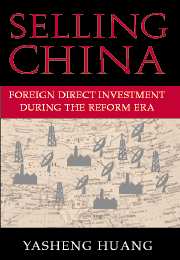Book contents
- Frontmatter
- Contents
- List of Tables and Figures
- List of Abbreviations
- Synopsis of the Book
- Preface
- Selling China
- 1 Introduction
- 2 An Analytical Framework
- 3 Problems in China's Corporate Sector
- 4 Constraints on Nonstate Firms and Foreign Direct Investment
- 5 State-Owned Enterprises and Insolvency-Induced Foreign Direct Investment
- 6 Economic Fragmentation and Foreign Direct Investment
- 7 Conclusion
- Bibliography
- Index
3 - Problems in China's Corporate Sector
Published online by Cambridge University Press: 05 June 2012
- Frontmatter
- Contents
- List of Tables and Figures
- List of Abbreviations
- Synopsis of the Book
- Preface
- Selling China
- 1 Introduction
- 2 An Analytical Framework
- 3 Problems in China's Corporate Sector
- 4 Constraints on Nonstate Firms and Foreign Direct Investment
- 5 State-Owned Enterprises and Insolvency-Induced Foreign Direct Investment
- 6 Economic Fragmentation and Foreign Direct Investment
- 7 Conclusion
- Bibliography
- Index
Summary
In 1998, as part of a program to “clarify ownership rights,” the Suzhou municipal government in Jiangsu province began to examine and sort through all the asset holdings under its control. One Suzhou firm, Suzhou Sanguang Group (Sanguang), was scrutinized particularly carefully. Sanguang was an urban collective firm; that is, in a formal accounting sense it was a wholly owned subsidiary of an SOE. While it was highly profitable, its parent SOE was deeply troubled and on the verge of bankruptcy. Now the Suzhou municipal government was very eager to claim Sanguang as its own. As the owner of all the SOEs in the city, it demanded every right to the assets of the subsidiaries of its SOEs.
The perspective of Sanguang was drastically different. Yes, Sanguang was a subsidiary of an SOE, but the government's only investment was a few pieces of old equipment in 1966 when Sanguang was founded. Nor did the state-owned banks lend any money to the firm. In the 1980s, Bao Zhishu, president of Sanguang, and his colleagues had borrowed equipment from other firms and personally paid for all travel expenses. Despite its slim profits, Sanguang paid a substantial amount of money to the parent SOE as “management fees.”
In the 1990s, Sanguang's businesses rapidly expanded as a result of two JVs that it had formed. In 1989, on the books, the total value of its assets was only RMB 420,000 ($112,000 at the 1989 exchange rate).
- Type
- Chapter
- Information
- Selling ChinaForeign Direct Investment During the Reform Era, pp. 106 - 150Publisher: Cambridge University PressPrint publication year: 2002



